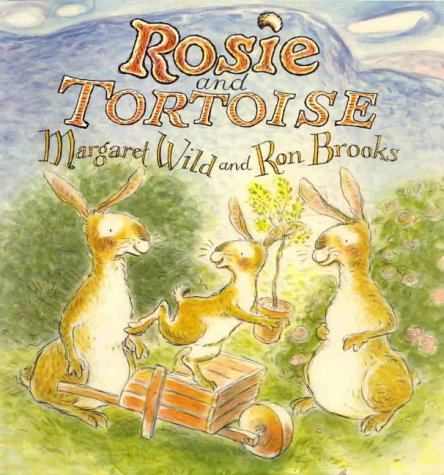Title of the work
Country of the First Edition
Country/countries of popularity
Original Language
First Edition Date
First Edition Details
Margaret Wild, Ron Brooks, Rosie and Tortoise. Sydney: Allen & Unwin, 1998, 32 pp.
ISBN
Genre
Picture books
Target Audience
Children (age 4–8)
Cover

Margaret Wild and Ron Brooks' Rosie and Tortoise (Sydney: Allen & Unwin, 1998). Courtesy of the Publisher.
Author of the Entry:
Elizabeth Hale, University of New England, ehale@une.edu.au
Peer-reviewer of the Entry:
Daniel A. Nkemleke, University of Yaoundé 1, nkemlekedan@yahoo.com
Elżbieta Olechowska, University of Warsaw, elzbieta.olechowska@gmail.com
Lisa Maurice, Bar-Ilan University, lisa.maurice@biu.ac.il

Ron Brooks
, b. 1948
(Illustrator)
Ron Brooks is one of Australia’s most distinguished illustrators. He was born in Pambula, on the far south coast of New South Wales, and grew up in Mallacoota in Gippsland in eastern Victoria before moving to Melbourne. He trained at Swinburne Technical School, and Royal Melbourne Institute of Technology. After working as a freelance artist and designer, he began illustrating children’s books with Jenny Wagner, including the award winning The Bunyip of Berkeley's Creek (1973) and John Brown, Rose and the Midnight Cat (1977). His illustrations have a distinctive style, with prominent linework and detailed backgrounds, but each of his books is unique.
He has illustrated many highly regarded picture books, which have won multiple awards in the children’s literature industry. His collaborations with Wagner (The Bunyip of Berkeley's Creek, John Brown, Rose and the Midnight Cat, Aranea) as well as Margaret Wild (Fox and Old Pig), Ursula Dubosarsky and Margaret Peversi have established him as a key figure in the development of Australian children's books. His autobiography, Drawn from the heart: a memoir, describes his approach to illustrating many of his classic works.
Sources:
allenandunwin.com (accessed: May 6, 2020).
austlit.edu.au (accessed: September 22, 2020).
"Brooks, Ron 1948–" in Lisa Kumar, Something About the Author,vol. 212, Gale: eBooks, 2010, 5–10.
Ron Brooks, Drawn from the Heart: A Memoir, Crows Nest, NSW: Allen & Unwin, 2010.
Bio prepared by Elizabeth Hale, University of New England, ehale@une.edu.au and Miriam Riverlea, Miriam Riverlea, University of New England, mriverlea@gmail.com

Margaret Wild
, b. 1948
(Author)
Margaret Wild was born in Eshowe, South Africa, in 1948. Her father was a bank manager, and the family moved frequently. She attended state schools in Johannesburg. She came to Australia in 1972. She studied at Australian National University in Canberra, and worked as a freelance writer and book editor in children’s publishing. Since 1984, she has published over 60 picture books, many of them award-winning, including Let the Celebrations Begin (1991, illustrated by Julie Vivas), which focuses on the release of Jewish prisoners from a Nazi concentration camp, and Fox (2000, illustrated by Ron Brooks), a fable-like story of friendship and betrayal. Wild’s work is known for exploring difficult issues—on identity, trust, death, and fear. She lives in Sydney.
Sources:
Magpies: Talking about Books for Children, Author entry on Margaret Wild, magpies-net-au (accessed: March 25, 2020).
Profile at Wikipedia (accessed: March 25, 2020).
Bio prepared by Elizabeth Hale, University of New England, ehale@une.edu.au
Summary
Rosie is a young hare eagerly waiting for her baby brother to be born. But when Bobby is born, he is tiny and weak. Rosie is scared, and avoids holding him or playing with him. As he grows (from being as heavy as an onion, to a potato, to a turnip, to "it won’t be long before he weighs as much as a cauliflower!"), Rosie remains afraid for her brother, and also afraid to connect with him. One day, her father asks her "why don’t you like Bobby?" "I do. It’s just… He’s so tiny, it makes me scared." Her father tells her a story, about a hare and a tortoise who are best friends, and who go gathering nuts in the forest. At home-time, Tortoise cannot find Hare, so he sets off alone, "slow and steady will get me home", he says, and little by little, he goes through the forest until he reaches the edge, and sees "what looked like a yellow moon moving through the trees. "It is Hare, coming to meet him with a lantern. Rosie thinks about the story, and thinks about Bobby, and his growth in weight, realising ‘Bobby is slow and steady, isn’t he?" That evening, Rosie holds Bobby for the first time: "Hey Bobby, hey there little Tortoise!"
Analysis
This touching story about a child who is worried about a fragile sibling, draws on elements of the Aesop’s fable: The Hare and the Tortoise, to reflect on expectations and senses of time and growth. Hares, known for their speed and quickness, are contrasted with the "slow and steady" Tortoise, who gets where he needs to go at the end. In this situation, there is no competition between the two animals; instead an understanding that they have complementary skills. The story of Hare and Tortoise allows Rosie to understand her brother’s different pace, and is useful for young readers who are adjusting to life with a new sibling. Wild carefully anchors this story in the natural world, with metaphors of rural growth, as Bobby puts on weight (from onion to potato…). Brooks’s gentle illustrations add a sense of warmth and love among the animals.


